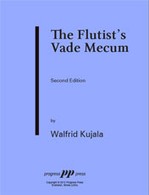
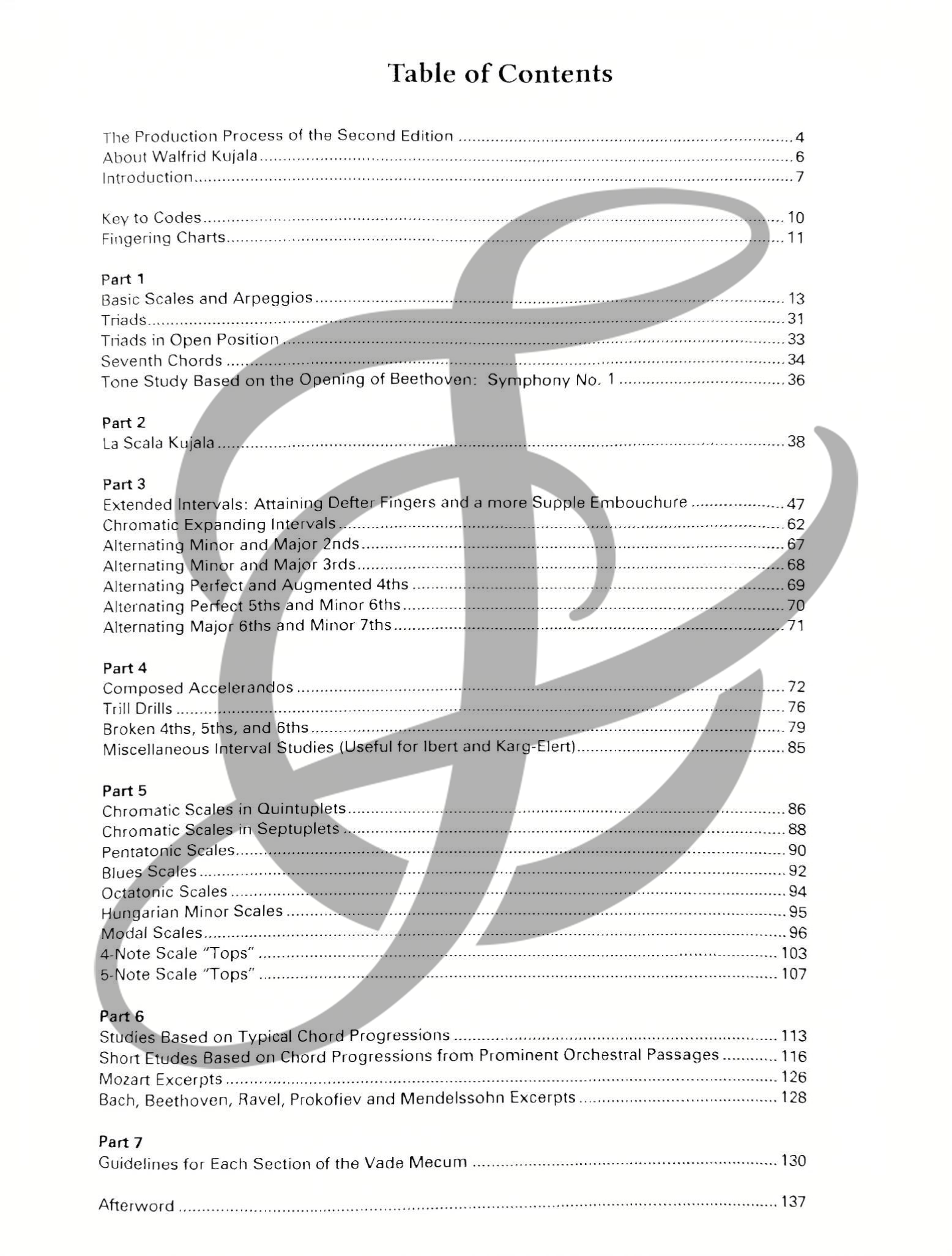
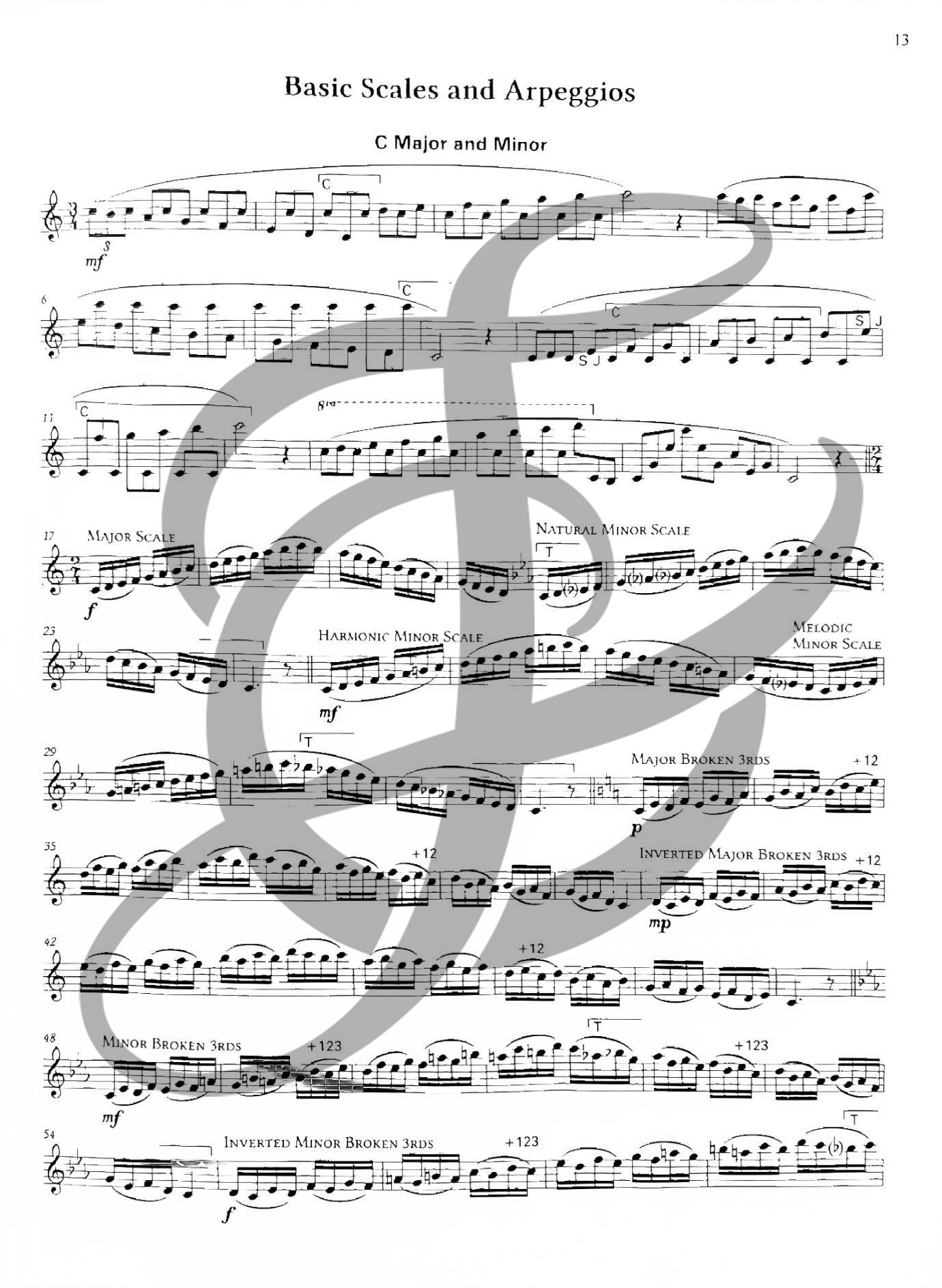
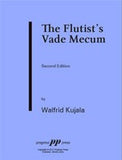

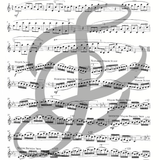
The Flutist's Vade Mecum, Second Edition
Description
The Flutist's Vade Mecum of Scales, Arpeggios, Trills and Fingering Technique, SECOND EDITION, by Walfrid Kujala, Published by Progress Press. Softcover.
Scroll down to learn more about a very good approach to learning the Vade Mecum: a PRACTICE SCHEDULE for the SECOND EDITION, designed to take you through carefully planned small portions of material. 12 Images [displayed as small red and white icons to the left of this copy under "LOOK INSIDE"] have been prepared to offer a visually-friendly guide to the full circle of all twelve key families - C through G.
NEW to this website:
AUDIO SOUND FILES for the Vade Mecum:
At the bottom of this page you will find a list of audio files, labeled by dark blue fields, to assist in an introduction to the Vade Mecum. These files are intended to demonstrate what the exercises sound like when executed with absolute perfection, with no "give-and-take" to accommodate difficult passages, the challenges of breathing, or the more treacherous pitfalls in sound production at the extreme ranges. A live performer will, of course, apply a tasteful "give-and-take" to faciliate his or her own statement of a piece. But often performers will decide that a ritard is "musical" when in fact it is merely accommodating a difficult technical passage. These habits can form without our realizing it, and these sound files serve as a check on our perception in this regard.
The fluidity of these passages in the audio files will hopefully encourage flutists to perfect their passages with strict discipline throughout. Having achieved absolute control of the execution of a part, the musician will then apply ritards, accelerandos, tenutos and the entire arsenal of expressiveness in a language that is truly good musicianship, and not merely speed bumps in the momentum to accommodate more challenging passages.
Some would argue that so much emphasis on metronomic perfection stifles expressiveness. But we believe that absolute control of one's technique "tool box" instills comfort to the degree that the technique becomes a subconcious support beam, and not the surface image, of a more expressive performance. The only way one can avoid thinking too much about technique is to master it.
The audio excerpts are an exact electronic realization of the examples contained in the book. They were created by Philip Rothman and NYC Music Services using Sibelius 7 and XSample Chamber Ensemble sample library.
For more information about Philip Rothman and NYC Music Services, visit:
http://www.nycmusicservices.com/
_________________________________________
A few words from WALFRID KUJALA about his Vade Mecum:
The Flutist's Vade Mecum, SECOND EDITION, is a greatly expanded, all-encompassing approach to the study and perfection of scale, arpeggio, trill and finger technique. As the author explains in the introduction of this softcover 135-page volume, "This book is intended not just for the initial learning of scales and arpeggios but for permanent and ongoing improvement of this material through diligent review. Each section is supplied with advice regarding the most appropriate practice methods (10 pages of explanatory text). Think of this Vade Mecum ("Go with me" in Latin) as a steady companion, always available for review and renewal."
In addition to the opening 18-page core section devoted to basic major, minor, whole-tone and chromatic scales, major and minor broken 3rds (including their inversions), the four triads, and diminished and dominant seventh chords, the Vade Mecum also highlights the following topics:
Regular coverage of the extremes of the flute range (low B, C, C# and altissimo B, C, C#, and D).
Expanded vocabulary of scales, including modal, pentatonic, octatonic, blues and Hungarian minor (17 pages).
Specific instruction on the use of atternate and "facilitating" fingerings.
Explicit notation of wide-ranging articulations and dynamics in the "Basic Scales and Arpeggios" section.
The use of five and seven-note groups, and odd meters.
Broken 4ths, 5ths and 6ths and their inversions, and chromatic broken 3rds (8 pages).
All triads and 7th chords presented in regular, inverted and broken form (4 pages).
Learning to make accurate rhythmic changes through "composed" accelerandos and ritardandos of scales (4 pages).
Trill exercises featuring a "measured" trill approach (3 pages).
NEW: Extended interval exercises for "attaining defter fingers and a more supple embouchure" (15 pages).
NEW: "La Scala Kujala", 10 pages of scale phrases excerpted from solo works, and organized into ongoing patterns.
Chromatic expanding interval studies (5 pages).
Chromatic scales in quintuplets and septuplets (4 pages).
Alternating minor and major intervals built on chromatic sequences of 2nds, 3rds, 4ths, 5ths, 6ths and 7ths (5 pages).
Excerpts from Bach, Beethoven, Mendelssohn, Mozart, Poulenc, Prokofiev and Ravel, with speciai fingerings (4 pages).
NEW: Short etudes based on chord progressions from various orchestral passages, with complete chord analysis (10 pages).
Broken chromatic minor and major 3rds.
4-note and 5-note scale "tops".
The first edition appeared in 1995 in soft cover 9 x 12. The new edition is expanded (44 pages longer!), soft cover, 10 x 13 smythe sewn pages so that it will rest on the stand in open position without stress on the spine of the book. This more durable format is truly designed for the concept of Vade Mecum ("Go with me"), intended to maintain structural integrity for the span of one's flute playing career.
"A refreshing skeptic to the dogmatic proponents of 'one note, one fingering', Kujala enjoys, as I do, devising alternate fingerings for quality, smoothness, intonation, and, I suspect, for fun... Above all, Kujala is a scientist of the flute, a thorough researcher, an experimenter, and a tolerant author who is not obsessed with certitudes, either his own or those of prior generations."
-Michel Debost, reviewing the 1st edition in Flute Talk, Feb. 1996
_________________________________________
Now for the PRACTICE SCHEDULE:
In the last paragraph of page 10 in the new edition of the VADE MECUM I write the following:
"As you work your way through the VADE MECUM, keep in regular touch with the first part, BASIC SCALES and ARPEGGIOS (pages 13-30), reviewing at least two keys daily (all 12 keys weekly). After you study the rest of the book, you can be selective about your daily review according to your needs (and challenges). For me, the section titled EXTENDED INTERVALS: ATTAINING DEFTER FINGERS AND A MORE SUPPLE EMBOUCHURE (pages 47-71) is also a valuable section for daily review. I usually do about two or three pages daily, both on flute and piccolo."
If you prefer to be more systematic in your review of the entire book, as I do, I would strongly suggest that you follow the 12 images under "Look Inside" near the top of this page for a good system of rotation.
The Images are each designed to contain 18 or 19 small sections of material that one can "conquer" daily, taking on one or two small sections per day, offering an interesting and somewhat comfortable plan of rotation.
To view the images, simply click on the upper right-hand image, which is an entire page devoted to small sections of material based on "C". This will open the image to full size. As you hover over the image with your pointer, notice the black circle with a white arrow on the rightand left edges of the image. As you click the right arrow, the images will advance to the next in the sequence: the C page is followeg by the F page, followed by the Bb page, and so on, all the way through the circle of fifths.
The left arrow will reverse the images back to C.
In your first "reading" you should aim to cover one entire page over a two-week period for a 24-week cycle for covering all 12.
After completing the 24-week cycle of 12 Images you should review the entire book again at the rate of one Preview Image per week for a 12-week cycle, increasing your tempos where appropriate, and applying a variety of dynanics and articulations.
Of course this schedule is quite intensive, when balanced with your other practice, so you may determine to expand the schedule to meet your needs. This is just a suggestion.
The VADE MECUM is a formidable monument of seemingly complex material, and while one can be discouraged by the sheer volume, breaking it into small, scheduled "doses" for a first encounter enables one to confront the material with much greater comfort and sense of control.
Our best wishes to you as you become familiar with the VADE MECUM, and as the title suggests, take the material with you as you confront all other repertoire and study.
Details
- Kujala, Walfrid
- Studies and Etudes
- 21st Century
Shipping
Flute Center offers free shipping on all US orders over $100, no code required - this will automatically be an option at checkout.
We are also happy to ship orders internationally!
Return Policy
Due to copyright laws of the US, no refunds will be permitted for sheet music except in the sole instance of our error in fulfilling proper products.
Read more about our sales and return policy here.
The Flutist's Vade Mecum, Second Edition
- Related products
- Recently viewed



